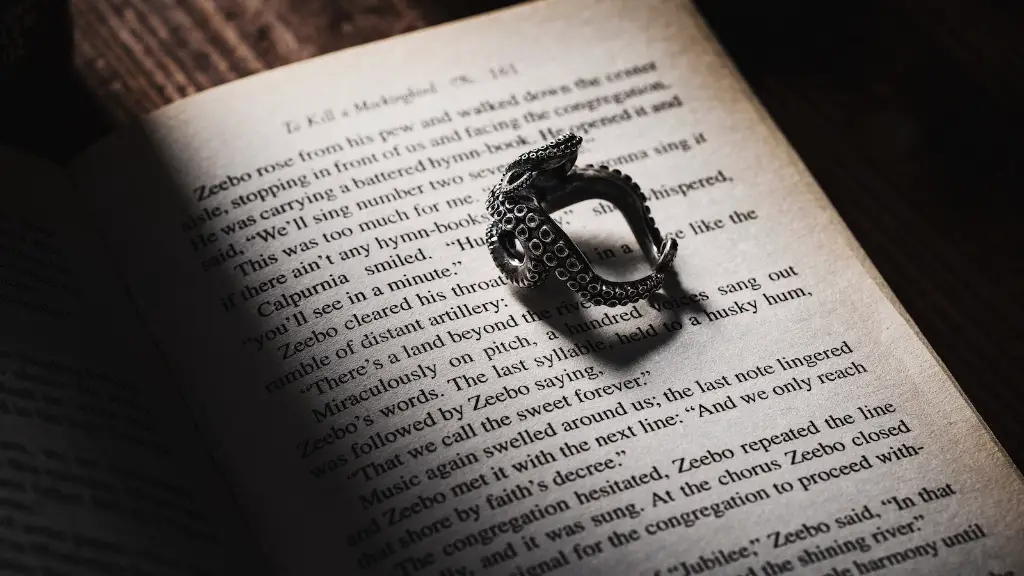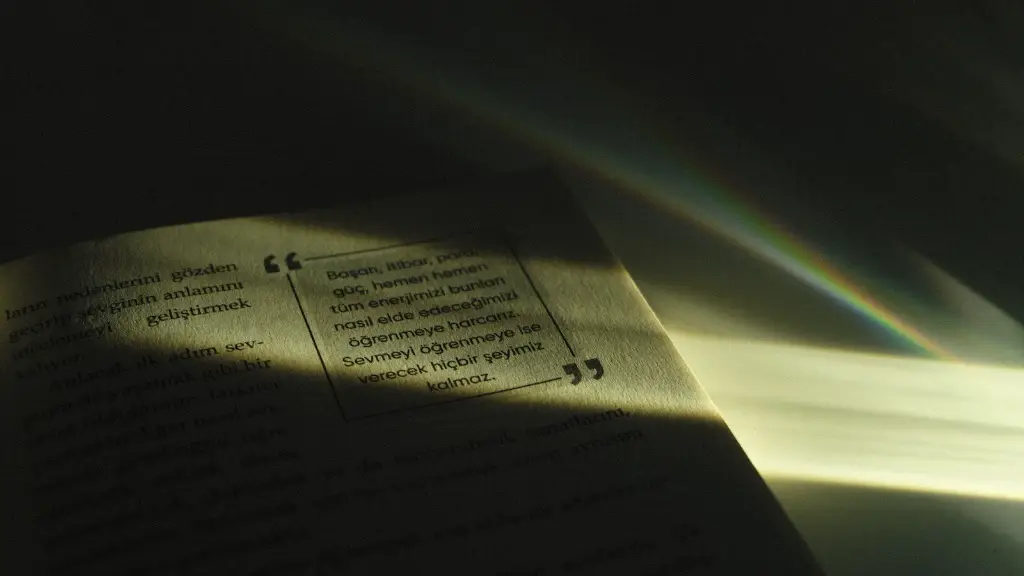Personification in poetry is an age-old literary technique used to ascribe human characteristics to inanimate objects, animals, abstract ideas or natural phenomena. Personification can give an object or concept an identity and help the reader better identify and connect with a poem’s subject. Personification also helps to create a mood, as well as add layers of meaning to a poem.
The use of personification dates back to storytellers of antiquity, though its use in poetry is more recently traced back to the works of the 11th century Persian poets, such as Rumi and Attar. Personification has been used extensively throughout literary history, and remains popular today. Notables examples include John Keats’ “Ode to a Nightingale” and Robert Frost’s “The Road Not Taken.”
At its core, personification helps poets to bridge the gap between the concrete and abstract, offering readers a vivid and relatable vision of a poem’s subject. Through personification, poets can give voice to inanimate objects, giving them feelings and personalities, or inject life and motion into animals, natural phenomena and abstract ideas. In doing so, poets reveal the inner life and feelings of the poem’s subject, often investing them with emotions and qualities that the reader can empathize with.
When it comes to recognizing personification in a poem, readers need to be on the lookout for descriptive words and phrases often used to suggest human characteristics. Common words used in personification include body parts, gestures and actions typically associated with humans, such as eyes, legs, hands, laughing, crying, running and so on. These can be used to describe inanimate objects, animals, natural phenomena and abstract ideas alike.
Another example of personification is the use of similes and metaphors to convey emotion. For example, the phrase “The old tree wept” is personification, as it suggests the tree has the capability to cry, something that only human beings can do. Similarly, the phrase “the sun smiled” is another example of personification, suggesting that the sun used facial expressions associated with happiness.
Figurative Language
Personification is closely related to figurative language, which is a literary device used to evoke emotion and create vivid imagery. Examples of figurative language include hyperbole, allusion, metaphor and simile. Personification is sometimes used as a form of figurative language, as it helps to convey emotion and add depth to a poem’s subject. Personification and figurative language are often used together in poems to create vivid imagery and to evoke emotion in readers.
For example, a poet may use the phrase “the wind whispered” to describe a gust of wind. By ascribing a human characteristic to the wind, the poet is able to evoke a feeling of stillness, peace and serenity, as opposed to the usual feeling of being “blown away.” By combining personification with figurative language, the poet is able to create an image that is more vivid, evocative, and impactful than words alone would be able to achieve.
Poetic Devices
Personification is often used in tandem with other poetic devices. An example of this is the use of anthropomorphism, which is when a poet gives human characteristics to animals or inanimate objects. This allows the poet to create a bond between the reader and the subject of the poem, as readers are able to empathize with the emotions of the animals, plants or objects portrayed in the poem.
In his poem ‘To a Mouse’, Robert Burn gives human characteristics to a mouse. By ascribing human characteristics, and describing the mouse’s struggles and fears, Burns expresses empathy and creates a bond between the mouse and the reader, enabling the reader to understand and share the mouse’s plight.
Personification is also often combined with imagery. Imagery is a literary device used to appeal to the senses, and enables poets to create vivid imagery in their work. By ascribing human characteristics to animals, objects and natural phenomena, poets are able to create vivid scenes, allowing readers to better visualize the poem’s subject.
Types of Personification
Personification can be broken down into three main categories: personification of objects and concepts, personification of abstract ideas and personification of animals and plants.
Personification of objects and concepts focuses on ascribing human qualities, physical characteristics and emotions to inanimate objects and concepts, such as a ‘raging storm’ or an ‘angry sea.’ By ascribing human characteristics to objects and concepts, poets are able to create vivid images and evoke a range of emotions in readers.
Personification of abstract ideas is used to give voice to things that cannot be seen, such as emotions, beliefs and ideas. Oftentimes, to personify an idea, poets will use a figure of speech such as metaphor or hyperbole to establish a relationship between the intangible idea and something tangible, such as a physical object. Through personification, poets can create vivid imagery to help readers understand and empathize with abstract ideas.
Finally, personification of animals and plants is used to ascribe human characteristics to animals and plants, as is the case with Robert Burns’ ‘To a Mouse.’ Through personification, poets can bring out the character of their subjects, as well as evoke emotion in readers by giving animals and plants human qualities and characteristics.
Metaphorical Meaning
Personification can also be used to convey a deeper, symbolic meaning. For example, a poet may use the personification of a river to suggest the passage of time and the speed of change, or personify a storm to convey a sense of foreboding and dread. By ascribing human characteristics to animals and plants, poets are able to take their readers on a journey, and help them connect more deeply with the poem’s subject.
Personification is also commonly used to impart moral or philosophical lessons. By giving animals and plants human characteristics, poets are able to illustrate the struggles and sorrows of everyday life, and impart their readers with lessons about the world and our place in it.
Personification of objects and concepts can also be used to make moral or philosophical points. By ascribing human characteristics to inanimate objects or abstract ideas, poets can offer their readers a perspective that can be difficult to express in words alone. Through personification, poets are able to evoke emotion and impart lessons in a way that is memorable and impactful.
Rhetorical Effectiveness
Personification is an effective rhetorical device, as it allows poets to bridge the gap between the abstract and concrete, and evoke a variety of emotions in readers. By giving voice to the unseen and unspoken, personification can create an emotional bond between the reader and the subject of the poem, and impart moral and philosophical lessons in a vivid and impactful way.
Personification can also be used to create vivid images and convey a deeper, symbolic meaning. By ascribing human characteristics to inanimate objects, plants and animals, and using figurative language and other poetic devices in tandem, poets are able to create powerful and evocative images, and convey the emotions and feelings of their subjects in an impactful and memorable way.
Purpose
Overall, the purpose of personification in poetry is to bridge the gap between the abstract and concrete, and evoke emotion in readers. Through personification, poets are able to give voice to the unseen and unspoken, and create vivid imagery to better express the struggles, sorrows and joys of the poem’s subject. Personification also allows poets to impart moral and philosophical lessons in a vivid and memorable way, helping readers to understand and empathize with the poem’s subject.
Beauty and Power
At its core, personification has the power to move its readers, creating a strong bond between the reader and the poem’s subject. By ascribing human qualities, emotions, and characteristics to objects, animals, plants and ideas, poets are able to impart a deeper understanding, and evoke emotion and empathy in readers. Personification is an age-old literary tool, and has the power to make the unseen and unspoken visible, allowing readers to better understand and relate to the poem’s subject.
Artistic Control
Personification also enables poets to have more artistic control over their work. Through personification, poets are able to create vivid imagery and evoke emotion in readers, as well as impart moral and philosophical lessons. By using personification, poets can control the mood of their work, and put their own spin on the poem’s subject. Personification also allows poets to create an emotional bond between their readers and the work, helping readers to understand, empathize and engage with the poem’s subject.
Symbolic Art
Personification can also be used to convey a deeper, symbolic meaning. By using personification, poets can represent abstract ideas, beliefs and emotions in tangible, human terms. Personification is also often used as a form of figurative language, and can be combined with other literary devices to create vivid imagery, and evoke a range of emotions in readers.
Personification has been used extensively throughout literary history, and remains a popular poetic device used by poets today. By giving inanimate objects, animals, plants and abstract ideas a voice, poets are able to bridge the gap between the abstract and concrete, create vivid imagery and evoke emotion in readers.





